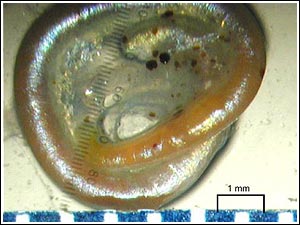

 |
||||||||||||
 |
||||||||||||
| Nematode (Roundworm) Infections in Fish | ||||||
| Page 10 of 11 | Pages: 1 . 2 . 3 . 4 . 5 . 6 . 7 . 8 . 9 . 10 . 11 | |||||
Contracaecum Species Larval stages of the Contracaecum species that infect freshwater fish are usually found as adults in fish-eating birds, such as cormorants and pelicans. Larval stages ( Figure 14 ) are seen in cyprinids (carp and related species), ictalurids (channel catfish), centrarchids (sunfish and bass), tilapia and other cichlids, and percids (perch). On the other hand, the larval stage of the Contracaecum species that infect marine fish, such as whiting, capelin, and cod, are typically found as adults in seals.  Figure 14: Larval Contracaecum sp. from a freshwater fish, showing typical coiled position.
Figure 14: Larval Contracaecum sp. from a freshwater fish, showing typical coiled position.
As implied above, Contracaecum species have complex life cycles. The eggs are released by gravid females into the intestinal tracts of their definitive (final) hosts, where they are excreted into the water with the feces. The eggs hatch and the free-living larvae develop into the infective third-stage larvae (L3). These L3 larvae are then ingested by an invertebrate intermediate host, within which they develop even further. This invertebrate host is then ingested by the fish intermediate host, where it remains until the intermediate fish host is eaten by the final host (a fish-eating bird or mammal). Some species of Contracaecum (e.g., C. spiculigerum) appear to have no specificity for fish hosts, so they are able to use a wide variety of fish species as intermediate hosts. Contracaecum species have been found in several locations within the body cavity of fish, including the liver, muscles, heart, and swim bladder. Diagnosis During necropsy of a small group of fish, tentative identification of infection by Contracaecum species can be made based upon finding larval nematodes in the locations listed above. However, because other nematodes have larvae which may look similar to larvae of Contracaecum, positive identification of Contracaecum infection needs to be made by an expert. Treatment Because of the location of larval nematodes in the freshwater fish intermediate host, chemical treatments, such as dewormers and chemical baths, are not an option and may even incite an immune reaction in the fish, ultimately doing more harm than good. Prevention Elimination of final hosts (bird or mammal) and invertebrate intermediate hosts from the aquaculture site will help reduce and, possibly, eliminate infection. more ... |
 |
|||||
| About Us :: Message Board :: Chat | |||||
| Library :: Photo Gallery :: Links & Resources :: Breeders & Sponsors :: Merchandise | |||||
| Website designed by: EthanCote.com | © 2001-2004, SimplyDiscus.com. All Rights Reserved. | ||||